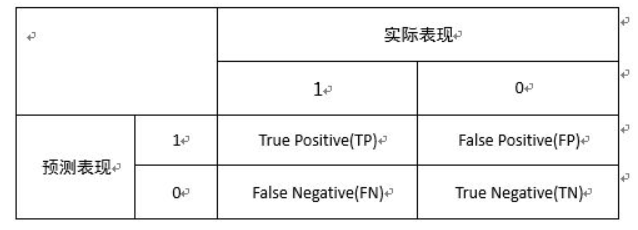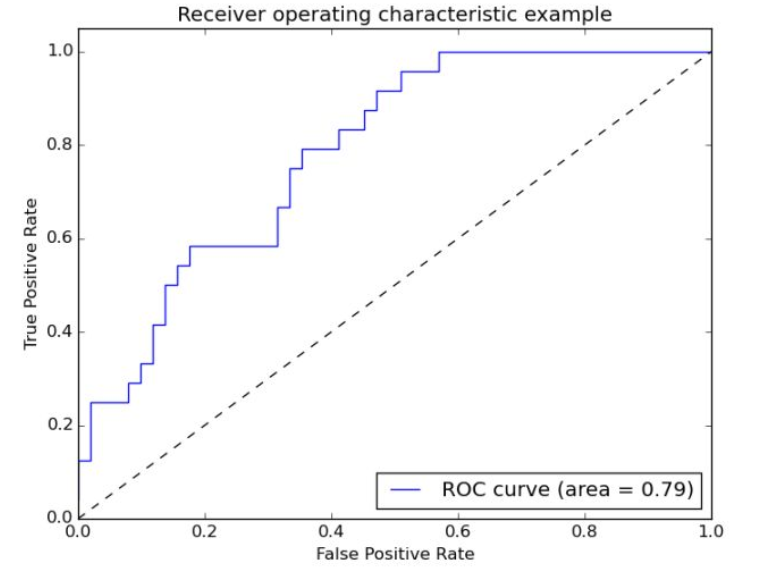TP Rate ,FP Rate, Precision, Recall, F-Measure, ROC Area,
https://www.zhihu.com/question/30643044

True Positive (真正, TP)被模型预测为正样本,实际为正样本;
False Positive (假正, FP)被模型预测为正样本, 实际为负样本;
True Negative(真负 , TN)被模型预测为负样本,实际为负样本 ;
False Negative(假负 , FN)被模型预测为负样本,实际为正样本;
举例:
实际样本标签 actual_issame = [1 1 1 1 1 1 0 0 0 0 0]
预测样本结果 predict_issame = [1 1 0 1 0 1 1 0 0 0 0]
实际样本标签 actual_issame_not = [0 0 0 0 0 1 1 1 1 1 1]
预测样本结果 predict_issame_not = [0 0 1 0 1 0 0 1 1 1 1]
正样本个数为6
负样本个数为5
TP + FN = 正样本个数为6
FP + TN = 负样本个数为5
TP = 4 TN = 4 FP = 1 FN = 2
贴一段计算代码
predict_issame = np.less(dist, threshold)
tp = np.sum(np.logical_and(predict_issame, actual_issame))
fp = np.sum(np.logical_and(predict_issame, np.logical_not(actual_issame)))
tn = np.sum(np.logical_and(np.logical_not(predict_issame), np.logical_not(actual_issame)))
fn = np.sum(np.logical_and(np.logical_not(predict_issame), actual_issame))
tpr = 0 if (tp+fn==0) else float(tp) / float(tp+fn)
fpr = 0 if (fp+tn==0) else float(fp) / float(fp+tn)
acc = float(tp+tn)/dist.size
return tpr, fpr, acc
以上面的为例
TP = 4 TN = 4 FP = 1 FN = 2
tpr = TP /(TP + FN)= 4/(4+2) = 66.7%
fpr = FP /(FP + TN)= 1 / (1+4) = 20%
acc = (tp+tn) / (总的样本个数) = (4+4) / 11 = 72.7%
True Positive Rate(真正率 , TPR)或灵敏度(sensitivity)
TPR = TP /(TP + FN)
True Negative Rate(真负率 , TNR)或特指度(specificity)
TNR = TN /(TN + FP)
False Positive Rate (假正率, FPR)
FPR = FP /(FP + TN)
False Negative Rate(假负率 , FNR)
FNR = FN /(TP + FN)
还有另外两个评价指标,针对正样本的评价指标
ROC曲线: TPR与FPR博弈的过程曲线,在不同阈值判决下
分类器希望的是TPR越大,FPR越小,
降低阈值可以使TPR变大,FPR也会越大
提高阈值可以降低FPR,但是TPR会降低
实际中需要根据实际场景进行合理选择阈值,
比如在人脸识别支付的时候,对FPR比较敏感,FPR越小,错误接收的用户可能性越小,用户的钱财越安全, 这个时候,可以提高阈值,降低FPR,TPR也会下降(用户体验会下降)。
在如精准营销领域的商品推荐模型,模型目的是尽量将商品推荐给感兴趣的用户,若用户对推荐的商品不感兴趣,也不会有很大损失,因此此时TPR相对FPR更重要,这个时候可以降低阈值。
